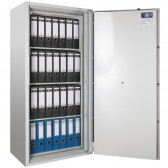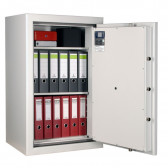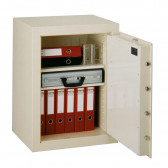If you're deciding to buy a safe for the first time, you need to answer a few questions. We will give you 5 simple tips on what you should look out for.
1. Security class
The first intuitive use for a safe is to secure cash, jewellery or bullion. In such cases, the decision to equip oneself with a safe will be accompanied by insurance of the contents against theft. If so, the value of what you want to keep in it, expressed in currency, will determine which safes you are interested in. This is the basic and most important parameter of a safe, which determines the useful value of the device. Without going into technological meanderings, in simple terms, as the class increases, so does the complexity and sophistication of the construction.
A hint here will be the Regulation of the Minister of the Interior, which regulates this relationship.
If, on the other hand, the purpose of the safe is to secure data, whether on paper or electronic media, you should be interested in models offering high certified fire resistance. Here, there are also several grades, most often expressed in minutes of resistance under the conditions stipulated by the standards.
There is a category of items whose value cannot be assessed, and yet a significant proportion of customers buy a safe with them in mind – these are heirlooms. A single photo of your grandmother, your parents' wedding ring, a photo album from primary school or letters written by your grandfather at the front are all possessions of no value to a burglar, but priceless to you and their loss cannot be compensated for. In this case, the choice of security class is an individual and very subjective risk assessment.
2. The weight of the safe
The second fundamental characteristic of your safe is its weight, which will be a direct result of its size and the class already discussed. The average break-in time is barely a few minutes or so. During this time, the thief's priority will be to take the most valuable loot as quickly as possible and escape. It is therefore crucial that he does not manage to snatch the safe and take it with him in such a short time. A reasonable minimum, assuming that the safe will be permanently anchored, is a weight of around 100 kg. As a rule: the greater the weight of the safe, the better. In accordance with EN 1143-1, any safe weighing less than 1,000 kg must be permanently anchored.
The location of the safe is also important. It is a bad idea to mount the safe to a wooden floor or plasterboard wall. It is worth choosing a location that you are comfortable with, depending on how often and how intensively you plan to use the safe. If you have a home office and the safe will be its daily accessory, it's a good idea for it to be close at hand, under the desk you work at or in your study. If you will look in the safe infrequently, mainly to stow things away before you leave, it can stand in a more secluded location.
3. Size of the safe
This feature of the device will be determined by how much space you need in the safe itself and how much space in your house or flat you can allocate to it. Most customers' first steps are towards compact safes, which are less than 50 cm in height. For home use and storing personal belongings, this is usually sufficient. If, on the other hand, you are buying a safe with long-term use in mind, then over time you may run out of space. We know from our own and our customers' experience that over the years, the number of documents, valuables, photo albums, discs with private content etc. increases, in which case it is worth investing in a safe which is sufficiently large.
On the other hand, the safe must not interfere with your personal living space. Intuitively and rightly, your first thought is to tuck the safe into a cupboard of some kind, and in most cases compacts fit perfectly. In the case of larger models, it is worth considering its placement in the workspace so that its presence does not interfere with the furnishings and your lifestyle. Ultimately, the size of the safe will be a product of these two viewpoints.
4. Interior fittings
The elements that your safe is to contain in it will follow directly from point 1, and therefore from what you plan to keep in there. The classic safe has one or more height-adjustable steel shelves. The shelves have a load-bearing capacity of up to several tens of kilos each, and this means that you can safely store gold bars on them, which is our sincere wish, but also binders, boxes or, for example, electronic equipment, which are heavy by definition. There are, however, circumstances that call for additional fittings, such as a vault with a separate lock (keyed, electronic) for storing ammunition, small arms holders or a drawer with file hangers, and even ventilation (in cabinets for lithium-ion batteries of dangerous substances). These are all items tailored to the specific model you have chosen.
When we have covered the basics, we are still left with the non-obvious aspect. How about going wild? A safe needs to be secure, but it can also be beautiful. If you are a collector of watches, numismatic items, small works of art or would simply like to make dealing with the safe an enjoyable activity every day – this is the right address. We are able to make a safe according to your taste and preference, only your imagination will be the limit. The vast majority of safes in the Signature and Exquisite ranges are one-of-a-kind safes. We don't do it alone, we invite you to actively participate in the creation of the project, from the choice of the base safe, the overall composition, the choice of materials (wood, glass, leather), the interior lighting, the colours and type of lacquer to the locking method. At all stages, you are with us, co-creating the safe for yourself to ultimately receive a work of engineering art with an individual serial number and a name you can give yourself.
See also other articles: How does a safe work?





